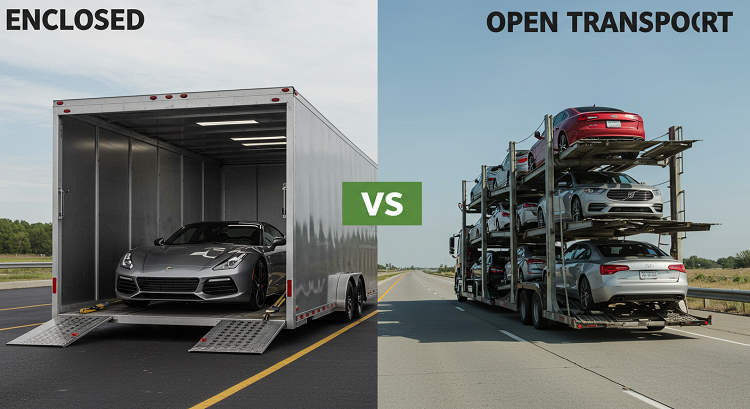Relocating to a new area is always a challenging experience. It becomes even more complicated if you’re planning a long-distance move that involves shipping your vehicle across the country. In this situation, you have two main options: enclosed and open carriers. Each method has pros and cons, making it important to understand both before making your decision.
Keep reading to explore the key differences in shipping methods and find the ideal transport solution for your relocation.
Table of Contents
Understanding Open Transport
Open transport is the most widely used method of vehicle relocation. In this method, your vehicle will be loaded onto open trailers that can carry multiple cars at once. Open transport is popular for transporting standard vehicles, making it an ideal choice for budget-conscious customers, dealerships, and those who need to move multiple cars at once. Though open transport offers a more cost-effective solution than enclosed transport, be sure to weigh both the pros and cons before choosing this option.
Pros of open transport
- More affordable. Open car transport is less expensive than enclosed transport. Since these trailers can carry multiple vehicles at once, the cost per vehicle is reduced.
- Widely available. Generally, open carriers are widely available. This increases the chance of finding a shipping company that can easily accommodate your preferred schedule and route.
- Faster shipping times. Since open transport is the industry standard, scheduling tends to be quicker compared to enclosed transport. This makes it a practical solution for last-minute car shipping needs, allowing for faster pick-up and delivery times, especially when you’re on a tight timeline.
Cons of open transport
- Exposure to weather and road debris. Vehicles transported on open trailers are exposed to various weather conditions, including rain, snow, and sun. They are also vulnerable to road debris, dirt, and dust. This exposure can potentially lead to minor cosmetic damage, such as scratches or paint chips, or may require a thorough wash upon arrival.
- Less protection for high-value vehicles. While cars are securely fastened on open trailers, they are not shielded from road debris, weather conditions, or other external factors. This lack of protection can be a concern if you are an owner of a high-value, luxury, or classic vehicle,
Understanding Enclosed Transport
Enclosed car shipping involves transporting vehicles in a fully enclosed trailer, providing the highest level of protection during transit. Enclosed transport is especially popular for luxury, classic, and high-value vehicles. Here are the main pros and cons of choosing enclosed transport for your vehicle relocation.
Pros of enclosed transport
- Maximum protection from weather, road debris, and theft. Enclosed trailers offer the highest level of protection for your vehicle, keeping it fully shielded from adverse weather conditions, road debris, and potential theft or vandalism. With this added layer of security, you can have peace of mind knowing your car will arrive in pristine condition, free from scratches, dirt, or damage.
- Ideal for high-value or rare vehicles. Vehicles transported in enclosed trailers are typically handled with the utmost care by experienced carriers. The extra protection and care make enclosed transport the ideal choice for high-value, rare, or classic vehicles, ensuring they are safely delivered without any risk of damage.
Cons of enclosed transport
- Higher cost. Enclosed car transport is generally more expensive than open transport. The higher cost is due to the increased level of protection it offers and lower capacity per trip.
- Limited availability, potentially longer wait times. There are fewer enclosed trailers compared to open trailers, which can lead to limited availability. As a result, you may experience longer wait times when scheduling transport, especially during peak seasons or on less common routes.
Cost Comparison: Open vs. Enclosed Transport
The cost of shipping a car using open transport versus enclosed transport can vary depending on several factors. The main factor affecting the cost is distance. As a general rule, the farther your destination, the higher the cost will be. Here is a breakdown of the price ranges for both open and enclosed transport, based on distances ranging from 400 to 2,500 miles:
- Open Transport: $390 to $1,300
- Enclosed Transport: $590 to $1,750
Factors influencing costs
Beyond distance, several other factors can impact the cost of transporting your vehicle:
- Vehicle size and weight. Larger and heavier vehicles cost more to ship. Trucks, SUVs, or luxury cars that require more space and special handling will generally incur higher shipping costs.
- Pickup and delivery locations. The cost of transport can vary depending on where the vehicle is being picked up and delivered. Remote or hard-to-reach areas may require additional fees, as carriers need to take extra time and effort to reach these locations.
- Season and demand. Demand for vehicle shipping tends to fluctuate based on the season. For example, prices may be higher during peak moving seasons (summer months or holidays). Planning ahead can sometimes help secure a better rate.
Final thoughts
Choosing between open and enclosed transport depends on your specific needs, budget, and desired level of protection. We hope this guide from BAH Logistics helps you make an informed decision and ensures you select the best transport option for your vehicle relocation.

